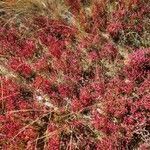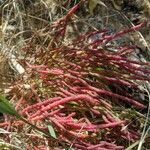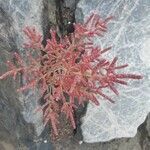Slender annual 1–2.5 dm; scales below the spike acutish, those of the spikes blunt or rounded; spikes very numerous, 1–5 cm, the joints 2–2.5 × 2–3 mm; central fl broadly rounded above the cuneate base, reaching nearly or quite to the node above, the lateral ones obliquely ovate; seeds 1–1.2 mm; 2n=18. Saline soil; w. Minn. to Sask. and w. Kans., w. to B.C. and Nev.
An annual herb. It is fleshy and erect. It grows 5-25 cm tall. The flowers are small but the central flowers in each cluster are longer than the side flowers.




